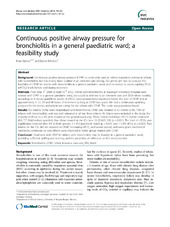| dc.description.abstract | Background: Continuous positive airway pressure (CPAP) is commonly used to relieve respiratory distress in infants with bronchiolitis, but has mostly been studied in an intensive care setting. Our prime aim was to evaluate the feasibility of CPAP for infants with bronchiolitis in a general paediatric ward, and secondary to assess capillary PCO2 (cPCO2) levels before and during treatment. Methods: From May 1st 2008 to April 30th 2012, infants with bronchiolitis at Stavanger University Hospital were treated with CPAP in a general paediatric ward, but could be referred to an intensive care unit (ICU) when needed, according to in-house guidelines. Levels of cPCO2 were prospectively registered before the start of CPAP and at approximately 4, 12, 24 and 48 hours of treatment as long as CPAP was given. We had a continuous updating program for the nurses and physicians caring for the infants with CPAP. The study was population based. Results: 672 infants (3.4%) were hospitalized with bronchiolitis. CPAP was initiated in 53 infants (0.3%; 7.9% of infants with bronchiolitis), and was well tolerated in all but three infants. 46 infants were included in the study, the majority of these (n = 33) were treated in the general ward only. These infants had lower cPCO2 before treatment (8.0; 7.7, 8.6)(median; quartiles) than those treated at the ICU (n = 13) (9.3;8.5, 9.9) (p < 0.001). The level of cPCO2 was significantly reduced after 4 h in both groups; 1.1 kPa (paediatric ward) (p < 0.001) and 1.3 kPa (ICU) (p = 0.002). Two infants on the ICU did not respond to CPAP (increasing cPCO2 and severe apnoe) and were given mechanical ventilation, otherwise no side effects were observed in either group treated with CPAP. Conclusion: Treatment with CPAP for infants with bronchiolitis may be feasible in a general paediatric ward, providing sufficient staffing and training, and the possibility of referral to an ICU when needed. | en_US |

